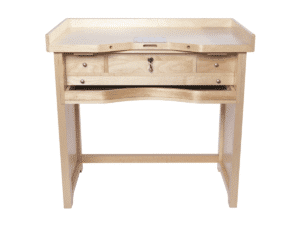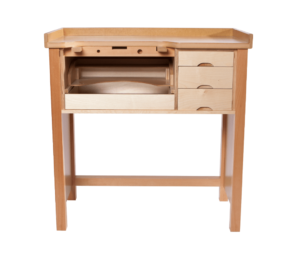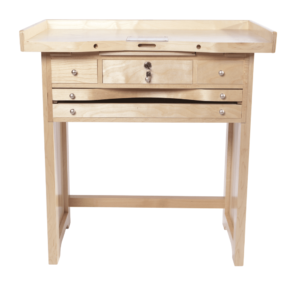A bench pin is an essential tool for jewelers, providing a stable platform for delicate tasks like cutting, filing, and shaping metal. It serves as an extension of your workbench, giving you more control and precision in your work. Installing a bench pin is a straightforward process that varies slightly depending on the type of pin and the design of your workbench. Whether you’re using a clamp-on or screw-in bench pin, this guide will walk you through the installation process step-by-step.
Materials Needed:
- Bench pin
- C-clamp (if using a clamp-on bench pin)
- Screws (if using a screw-in bench pin)
- Screwdriver or drill
Step-by-Step Installation Guide
- Determine the Type of Bench Pin
There are two common types of bench pins, and knowing which one you have will determine how you install it:
- Clamp-on Bench Pins: These attach directly to the edge of your workbench using a C-clamp. No permanent alterations are needed.
- Screw-in Bench Pins: These require screws to fasten the pin directly to your workbench. You’ll need to drill holes and secure it with screws for a more permanent installation.
- Position the Bench Pin
The position of the bench pin is crucial for comfortable and efficient use.
- For Clamp-on Bench Pins: Choose a stable, sturdy edge on your workbench. Position the pin in front of your main work area, where it will be easily accessible. Make sure the area you choose allows you to work without any interference.
- For Screw-in Bench Pins: If your workbench has a pre-cut notch or hole for a bench pin, align the pin over that spot. If not, choose an area that offers good accessibility and convenience for your tasks, such as cutting and filing.
- Attach the Bench Pin
Depending on the type of bench pin you are using, the installation method will differ slightly.
- Clamp-on Bench Pins:
- Place the C-clamp over the edge of your workbench where you’ve positioned the bench pin.
- Tighten the clamp securely to ensure the pin stays firmly in place during use. The pin should not wobble or shift as you work.
- Screw-in Bench Pins:
- Align the bench pin over the desired spot.
- If the workbench doesn’t already have pre-drilled holes, mark the spots where you’ll need to drill.
- Drill pilot holes to make inserting the screws easier and to ensure the pin is securely fastened.
- Use screws to attach the bench pin to the workbench, making sure it is tightly secured.
- Test the Stability
Once installed, test the stability of your bench pin by applying some pressure. Push and pull gently to ensure it doesn’t move or shift during use. If it feels loose, tighten the screws or clamp further until the pin is stable and secure.
- Customization (Optional)
Many jewelers customize their bench pins to suit their specific needs. You can add grooves, notches, or small holes to better hold materials during intricate tasks. These modifications can enhance the efficiency and precision of your work.
Additional Tips for Bench Pin Installation:
- Comfort: Make sure the bench pin is at a comfortable height relative to your sitting or standing position. Since you’ll spend a significant amount of time working on it, proper positioning is key to avoiding discomfort or strain.
- Stability: If you find that a clamp-on bench pin moves or shifts frequently during use, you may want to consider switching to a screw-in model for greater stability.
By following this guide, you can securely install your bench pin and create a stable, reliable work surface for a variety of jewelry-making tasks. Whether you’re cutting, filing, or shaping, a well-installed bench pin will improve your precision and efficiency.
Need some inspiration? Check out other blog posts!
Browse Jeweler's Workbenches

Featured

Small Workbenches

Small Workbenches

Small Workbenches





